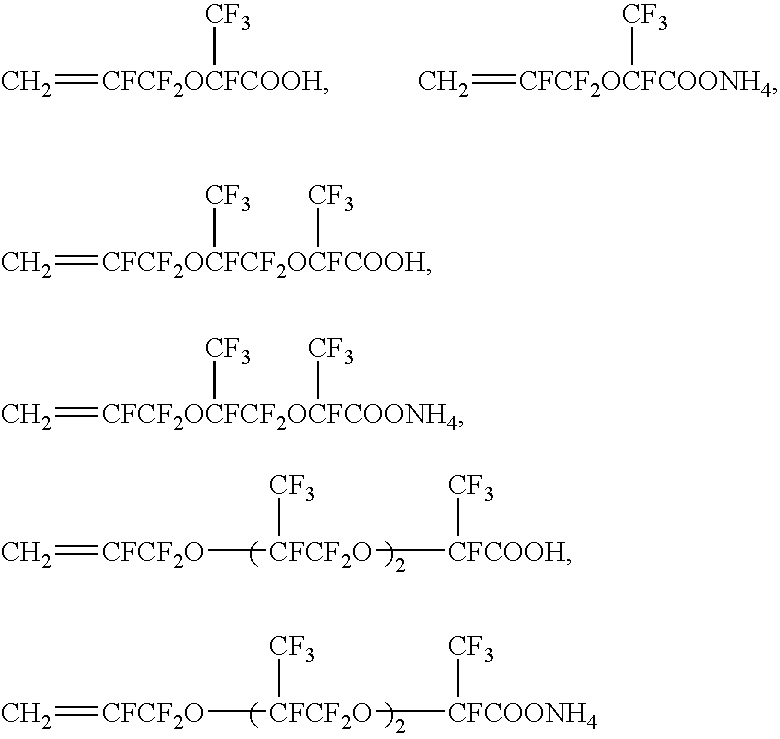Method For Producing Fluorine-Containing Elastomer Polymer
- Summary
- Abstract
- Description
- Claims
- Application Information
AI Technical Summary
Benefits of technology
Problems solved by technology
Method used
Image
Examples
example 1
[0153]A 2-liter stainless steel pressure vessel equipped with a stirrer was charged with 1000 ml of deionized water, 2.0 g of ammonium perfluoro(9,9-dihydro-2,5-bistrifluoromethyl-3,6-dioxa)-8-nonenoate [RS-1] as a vinyl group-containing fluorinated emulsifier and 5 g of diethyl malonate as a chain transfer agent and, after repeated pressurization with nitrogen and vacuum degassing, 430 g of HFP was introduced into the vessel at a reduced pressure of −700 mmHg, followed by introduction of a fluoromonomer mixture composed of VDF / HFP=95.5 / 4.5 mole percent (hereinafter such fluoromonomer mixture is referred to as “mixed monomer”) was introduced into the vessel to thereby raise the pressure to 6 MPa at 80° C. Then, 13 g of a 2% (by mass) aqueous solution of ammonium persulfate was introduced under pressure, upon which the pressure was found to fall. Therefore, a mixed monomer composed of VDF / HFP=95.5 / 4.5 mole percent was then continuously added to maintain the vessel inside pressure at ...
example 2
[0157]The polymerization was carried out for 3 hours in the same manner as in Example 1 except that 0.07 g of ammonium perfluoro(6,6-dihydro-2-trifluoromethyl-3-oxa)-5-hexenoate [RS-2] was used as the vinyl group-containing fluorinated emulsifier, whereby 1370 g of an aqueous emulsion was obtained.
[0158]This aqueous emulsion had a solid matter concentration of 28.6% and an average particle diameter of 130 nm.
[0159]The washed and dried coagulation product obtained from the aqueous emulsion through the same steps of coagulation, washing and drying as in the Example 1 had a composition of VDF / HFP=78.4 / 21.6 mole percent (60.8 / 39.2% by mass) and a Mooney viscosity at 100° C. of 63.1.
example 3
[0160]The polymerization was carried out for 3.5 hours in the same manner as in Example 1 except that 0.10 g of ammonium perfluoro(5-trifluoromethyl-4,7-dioxa)-8-nonenoate [RS-3] was used as the vinyl group-containing fluorinated emulsifier, whereby 1384 g of an aqueous emulsion was obtained. This aqueous emulsion had a solid matter concentration of 27.8% and an average particle diameter of 237 nm. The washed and dried coagulation product (elastomeric fluoropolymer) obtained through the same steps of coagulation, washing and drying as in the Example 1 had a composition of VDF / HFP =77.6 / 22.4 mole percent (59.6 / 40.4% by mass) and a Mooney viscosity at 100° C. of 62.6.
PUM
| Property | Measurement | Unit |
|---|---|---|
| Fraction | aaaaa | aaaaa |
| Fraction | aaaaa | aaaaa |
| Percent by mass | aaaaa | aaaaa |
Abstract
Description
Claims
Application Information
 Login to View More
Login to View More - R&D
- Intellectual Property
- Life Sciences
- Materials
- Tech Scout
- Unparalleled Data Quality
- Higher Quality Content
- 60% Fewer Hallucinations
Browse by: Latest US Patents, China's latest patents, Technical Efficacy Thesaurus, Application Domain, Technology Topic, Popular Technical Reports.
© 2025 PatSnap. All rights reserved.Legal|Privacy policy|Modern Slavery Act Transparency Statement|Sitemap|About US| Contact US: help@patsnap.com



